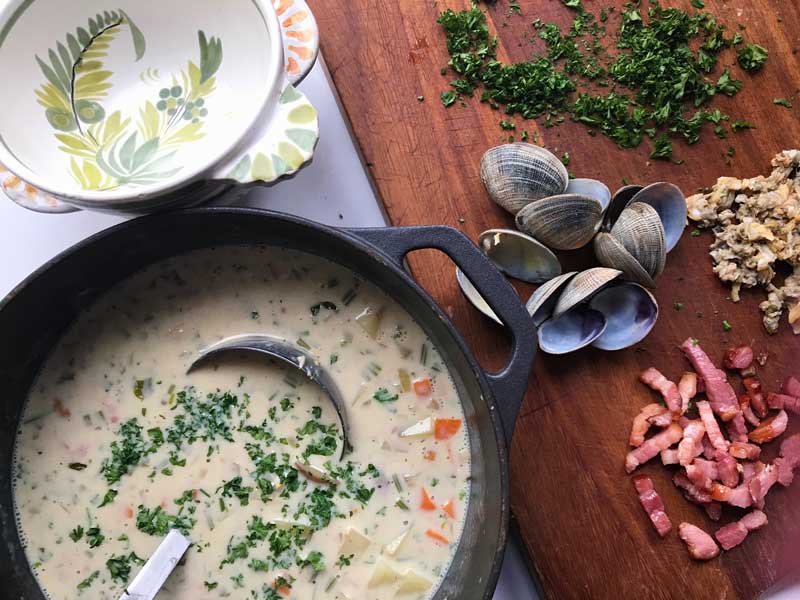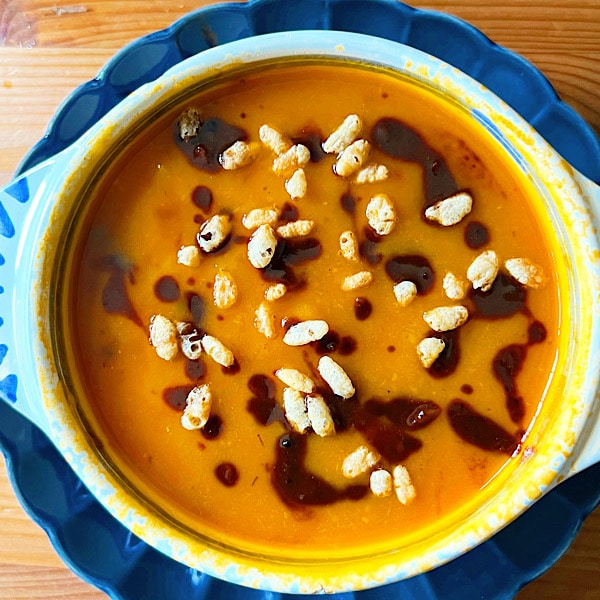Ever since I got bitten by the clam-digging bug about five years ago (I can walk two hundred yards out onto the mudflats just in front of my house in Cancale and get a bucketful of steamers in about an hour, so now I do that every chance I get.), I also became taken with introducing my French friends to homemade clam chowder. In a land where clams are traditionally only eaten raw, baked with escargot butter, or tossed with pasta à l’italienne (and that’s about it on the home-cooking scene), a thick, veggie-laden soup that’s fragrant with clams and their liquor is quite the party trick. (And those “Oh-la-la…c’est bons…” are just music to a cook’s ears.) Plus it’s just so easy to make!
The New England Clam Chowder version I’ve finally settled on (here) takes into account my personal preferences. I like a lighter base—more milk, less cream—but one that still has some thickness and body to it (i.e., a flour roux). I put in lots of potatoes, celery, and carrots so there’s a little bit of everything in every bite. And I don’t add the cooked bacon or clams till the very end so that their strong, distinct flavors don’t get lost in all that creamy liquid.
This recipe has been put to the most stringent test I can think of: a luncheon of neighbors whose families have been fishing in Cancale for many generations and therefore know a thing or two about preparing seafood. When they asked me for the recipe, I knew I’d gotten it right.
2 lb. (1 kg.) steamer clams, or 2 6.5 oz. cans of minced clams, drained, liquid reserved
¼ lb. bacon
2 Tbs. butter, optional
1/2 small onion, finely chopped (1/2 cup/75 g.)
2 celery stalks, sliced (1/2 cup/75 g.)
2 Tbs. (15 g.) all-purpose flour
2 medium red-skinned potatoes, diced (1 cup/150 g.)
1 large carrot, diced (1/2 cup/75 g.)
sprig of fresh or dried thyme
1 bay leaf
1 to 1 ½ cups milk
2 Tbs. (30 g.) crème fraiche or heavy whipping cream, or more to taste
chopped parsley, for garnish
Soak the clams in a large bucket of sea water or heavily salted water 4 hours, or overnight to purge them of any sand or grit. Scrub the clams, then place them in a large Dutch oven. Heat, covered, over high heat until all the clams open. Cool, then remove the clams from their shells and coarsely chop. (You should have about 1 cup/1/2 lb./250 g. of clams.) Strain the clam liquor through a fine-meshed sieve (lined with cheesecloth if the clams were especially gritty), and transfer the liquor to a measuring cup. Add enough water to make 1 1/2 cups of liquid. Taste the liquid. If it seems too salty, add more fresh water, but only keep 1 1/2 cup of the liquid. (If you’re using canned clams, you can skip this step and just add enough water to the clam juice in the cans to make 1 1/2 cups.)
Rinse out the Dutch oven (or pot), then cook the bacon in the pot over medium heat until crispy. Drain on paper towels, then coarsely chop the bacon. If there is enough bacon grease in the pot to cook the onions (about 2 Tbs.), use this, otherwise, add the butter to the pot.
Sauté the onions and the celery 3 to 5 minutes, or until soft and translucent. Sprinkle the vegetables with the flour, and cook 30 seconds to 1 minute, or until the vegetables are coated and the flour begins to stick to the pan. Add the potatoes, carrot, thyme, bay leaf, and the reserved clam liquid. Cover, and bring to a boil. Reduce the heat to medium-low, and simmer the chowder 10 minutes.
Meanwhile, scald the milk in a small saucepan. Remove the bay leaf and thyme sprig from the chowder. Stir the scalded milk into the chowder along with the crème fraiche or cream, then add the bacon and clams. Cover the pot, and let stand 5 minutes for the flavors to develop. Serve sprinkled with chopped parsley. If the chowder seems too thick, add a little more milk or water to obtain the desired consistency. When reheating, avoid bringing the chowder to a boil. Makes 4 servings



Nice recipe, but I am in France, and when I look for canned clams in the supermarche, I can’t find any. Do you have any recommendations for where to find canned clams?
Hi Leonard, I’ve had luck finding (and stocking up on) canned clams when my local supermarché has a Spanish-themed week. You can also find them in Spanish and Portuguese groceries (if you have any nearby). Otherwise, fresh clams from the poissonnier or, if they’re too expensive, you can substitute mussels. Hope that helps! MM
Thanks for the recipe. I’m not good at cooking, but I miss good New England Clam Chowder living in France. So I guess it’s time to try it out. One question though. Can I make it without the bacon? I don’t remember having it in the soup in the US. How important is the bacon in your opinion?
Hi Dimitri, yes you can skip the bacon if you like (the clams should have plenty of flavor), but I like the smokiness it brings. Also, this chowder is kind of thin (the way I like it). If you want a richer, thicker chowder, add an extra tablespoon of flour and use half milk, half cream.